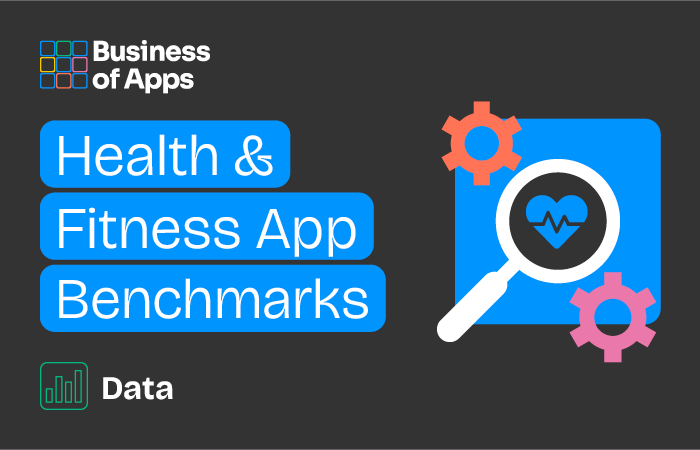Health & Fitness App Benchmarks (2024)

The health and fitness app industry covers three main pillars: health, fitness and wellness. All three are connected to maintaining a healthy lifestyle, and apps tend to pick and choose a few things to track from each.
This was one of the industries that had both positive and negative effects from the pandemic. Home workouts shot up in usage, while all gyms were closed for a time. Wellness apps also noticed an uptick in users.
Since the pandemic, the health and fitness app industry has lost some of its dazzle, with some moving back to regular gym and offline exercise. But some of the habits developed during the pandemic have stuck, with more users tracking calories, gym workouts and mental wellbeing through apps than they did pre-pandemic.
The health and fitness app industry has been focused on subscriptions for a while now, with most apps having some form of premium service. This can be in the form of more classes, expert analysis, personalized gym routines and access to professionals.
At the platform level, there is usually a hardware element involved as well. Apple, Google, Fitbit, Peloton, Oura and others all generate most of their income from hardware sales, with subscriptions taking a backseat. That said, over the past three years subscriptions have made up a higher percentage of most fitness hardware suppliers revenue.
We have collected data and statistics on health and fitness app benchmarks. Read on below to find out more. Explore further with our in-depth health & fitness app report.
Key Health & Fitness App Benchmarks
- Health and fitness apps had 3% retention rate by day 30 in 2023
- Conversion rate is higher on Google Play for health and fitness apps than iOS
- Activation rate for health and fitness apps was 26% on day one, dropping to 10% by day 28
- Annual subscriptions to health and fitness apps have a 33% retention rate
Health & Fitness App Retention Rate
The retention rate for health and fitness apps was 3% by day 30 according to AppsFlyer. In Adjust’s report it is a bit higher at 8% on day 30, from 27% on day one.
Health & fitness app retention rate 2020 to 2023 (%)
Health & fitness app day one to day 30 2023 (%)
Health & Fitness App Conversion Rate
Conversion rate for health and fitness apps was higher on Google Play than iOS.
Health & fitness app conversion rate by platform 2023 (%)
Health & Fitness App Install Rate
Install rate across Tier 1 countries, Asia and Europe were quite similar, with a large drop off for Latin America.
Health & fitness app install rate by region 2023 (%)
Health & Fitness App Activation Rate
Activation rate for health and fitness apps reached 10% by day 28, according to Airship.
Health & fitness app activation rate day one to day 30 (%)
Health & Fitness App Sub Retention
Retention rates are higher the longer the subscription duration, but it tends to be much harder to get a user to sign up for longer.
Health & fitness app sub retention rate by duration (%)
Health & Fitness App Renewal Rate
Weekly and monthly subscriptions have similar renewal rates, while annual is much lower. It should be noted however that more than 50% of users have been churned from weekly and monthly subscriptions by the third renewal, and would have contributed less than an annual subscriber.
Health & fitness app renewal rate by duration 2023 (%)
Health & Fitness App Daily Usage
On average users spend four minutes on health and fitness apps every day, so it’s important to maximize the experience given the short window.
Health & fitness app 2019 to 2023 (minutes)
Related
Yaslen Clemente Shows Off Leg Day Gains and Shares Her…
Yaslen Clemente isn't just an influencer—she's a fitness powerhouse. The social media star is known for her intense workouts, and she recently sha
Samantha Espineira Stuns in Blue Swimsuit and Shares Her 5…
Samantha Espineira knows how to turn heads, both on and off the runway. The successful model and Instagram influencer regularly shares breathtaking
The Best Fitness Trackers To Help You Reach Any Health…
Best Health Tracker: Oura Ring 3Why We Love It: I’ve tried many, many fitness trackers—but I tend not to stick with one watch or band for very long. I’ve
#CycleSyncing debunked: Popular TikTok trend not backed by science
A new study has debunked a popular TikTok wellness trend called cycle syncing, which claims that tailoring a workout routine to match the hormonal changes that













